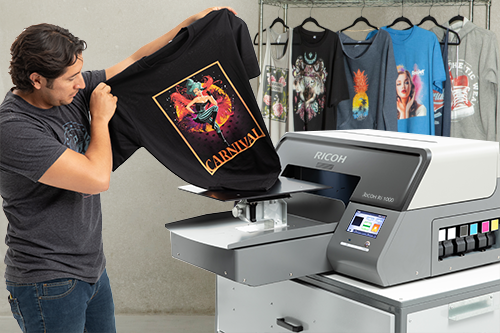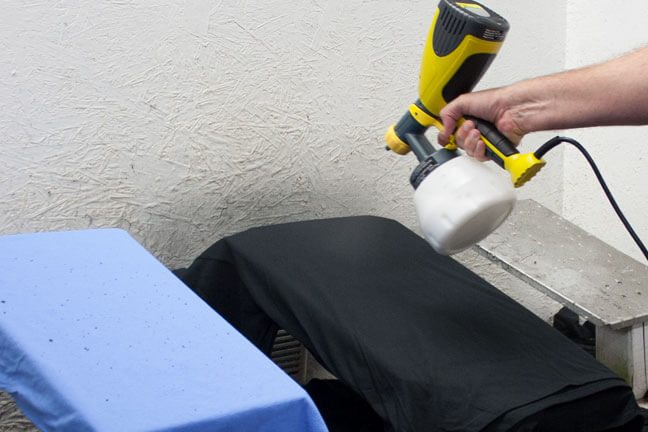
The automatic response when you say something funny or clever is usually, “That should go on a t-shirt!”
Have you ever wondered what it would take for you to actually get that done?
Direct-to-garment printing is currently one of the most popular printing options out there, but is it the right choice for your business?
Read on to find out all there is to know about DTG printing t-shirts and the incredible impact this technology can have on the growth of your business.
Direct-to-garment (DTG) printing is a fabric-printing method that sprays ink directly onto the garment. In essence, it’s how printing on fabric would work if you shoved a garment into a regular office printer.
During the printing process, one layer of water-based ink is applied to the t-shirt and sinks into the fibers of the garment.
The technology allows for intricate, detailed designs with an unlimited color palette at your disposal. It is perfect for elaborate t-shirt designs and designs with a ton of different colors.
The digital nature of this printing process gives it the highest DPI (dots per inch) of all fabric printing techniques! Dots per inch is a measure of resolution. The more dots per inch, the higher the image quality.
DTG printing results in bright, full-color designs because it uses white ink. Other printing methods simply leave any white areas in the design unprinted.
Direct-to-garment printing has become increasingly popular because of the high-quality images it can produce. But the benefits don’t stop there…
Because DTG printing has an extremely short setup time, it’s easy to print one-off designs. This allows you to print designs on-demand, removing the need for bulk orders and storing large amounts of stock.
On-demand printing also means you have the flexibility to introduce new styles, designs, and colors risk-free!
The on-demand aspect of DTG printing means no more ordering in bulk when you only need a handful of t-shirts to be printed. You can order on-demand with no upfront cost.
DTG printers process images using pixels, which means they can handle printing extremely precise details.
You can easily achieve highly detailed and even photographic designs using DTG.
Easy setup and easy clean-up mean that once the artwork for your t-shirt is approved, printing can begin right away. Same-day DTG printing is easily achieved!
DTG printers can print around 60 orders a day, so larger orders may take some time to be completed. The image quality is worth the wait.
Compared to screen printing, DTG is a much more sustainable fashion business model. Because of its ability to print designs one-off, DTG printing results in no overproduction and next to no textile waste.
Nearly 92 million tons of textiles go to waste every year, so a business model like this is a game-changer!
On top of this, many manufacturers of DTG printers prioritize sustainability in their technology. Some businesses produce DTG printers with almost zero wastewater and use high-quality, non-hazardous, biodegradable, and toxin-free inks.
DTG printing optimizes speed, efficiency, and consistency.
Considering the incredible quality of DTG printed garments, it may come as a surprise to you how short the equipment and supplies list actually is!
If you want to print a colorful design on your t-shirt, you need colorful ink! The ink used for DTG printing is water-based.
Pretreatment is a liquid that contains chemicals to help the inks bond with the shirt fibers to ensure you end up with vibrant colors and clear images.
High-quality DTG inks and pretreatment is maintained in strictly controlled environments. Climate control ensures they both function optimally.
White ink in particular needs to be tumbled before use to help with pigment distribution as well as the binding process.
These strict conditions help guarantee consistent results from DTG printing. The colors will be consistent from t-shirt to t-shirt, no matter how many times the design gets printed!
You need a digital version of your design for the DTG printer to understand it.
Use a computer or any other device with graphic design software to create your design.
This machine prepares the t-shirt for printing.
Pretreatment promotes a stronger bond between the t-shirt and the ink, lays down any loose fibers so that the printer has a smooth surface to work on, and chemically reacts with the ink to speed up drying and curing.
The heat press dries the t-shirt once after pretreating and again during the curing process.
A heat press is like a really big iron. It applies heat and pressure to the garment which helps seal pretreatment into the shirt and dry the t-shirt after printing.
Direct-to-garment printing requires a specific type of digital printer which handles fabric the same way an office paper handles paper.
Beyond these few pieces of equipment, DTG printing doesn’t require anything else to get going! This makes the set-up cost per garment extremely low.

You don't have to give up on your t-shirt dreams if you aren't able to get your hands on a DTG printer of your own (which makes sense, pro machines can cost up to $500,000). The print-on-demand nature of DTG printing means that DTG printing services are easy to access!
DTG printers take images and divide them into pixels. A pixel is the smallest measurable point in a photo or image.
The first step in DTG printing is to design something to be printed. You can use graphic design software like Photoshop to design shirts, draw up a company logo, your favorite cartoon character, a meaningful quote, or anything you can think of!
The DTG printing process is simple as 1, 2, and 3.

A pretreating machine prepares the t-shirt for the printing process. This step only takes a few seconds, but is a vital part of the process!
Pretreatment involves a liquid that acts as a bonding agent after exposure to heat. It's particularly important for printing lighter colors on dark fabrics.
This step helps keep colors vibrant and solid, increases the level of detail in the final t-shirt, stops colors from bleeding together, and helps the colors stand up to washing.
A heat press set to 330 degrees Fahrenheit dries the shirt for around 20-30 seconds. Once the fabric is completely dry, we move on to the next step...
The t-shirt is carefully positioned and held in place by a hoop.
The printing process is as simple as pressing 'print'. Once the design is programmed into the DTG printer, there's nothing complicated about the process at all!
For darker garments, the printer might lay down an 'under base' of white ink to help with color vibrancy.
After the design is printed onto the t-shirt, the ink needs to be cured using the heat press.
Just like earlier, it is heated to 330 degrees Fahrenheit. This time around, however, a sheet of protective silicone is used to protect the design from the extreme heat.
After 90 seconds, your t-shirt is ready to be worn!
Because it uses water-based ink, DTG printing is best done on natural fabrics with no more than 20% polyester. You will get the best results on ringspun 100% cotton, regular 100% cotton, 50/50 poly-cotton blends.
You want to use at least 30 singles ringspun cotton for the best print quality and clearest images. This number refers to the gauge (thickness) of the individual threads in the cotton. The higher the number, the thicker the threads!
Our recommended t-shirts are Gildan G500 & G640, Bella+Canvas 3001 and Next Level 3600
Some t-shirts are better to print on than others. Make sure to do your research before accidentally printing your design onto a t-shirt that won't do the vibrant colors justice!
T-shirts are forgiving garments when it comes to subpar design, but that doesn't mean you don't want to at least try to come up with something good.
Use these DTG printing tips to make sure your t-shirt comes out perfectly.
Direct-to-garment printing allows for stunning precision in design production, allowing you to go as complex as you like when deciding what to add to your design.
The best tip when designing your t-shirt is to save your design in the highest resolution possible to ensure detailed graphics.
Since DTG printers use the CMYK color mode, you want to save your design in that mode too. This tip ensures the colors of your final t-shirt match those in the design on your computer!
Direct-to-garment printing on t-shirts is the best way to create gorgeous, detailed, and colorful designs that you can wear every day.
Here at AllDayShirts.com, we have hundreds of blank t-shirts just waiting for your designs to be printed on them.